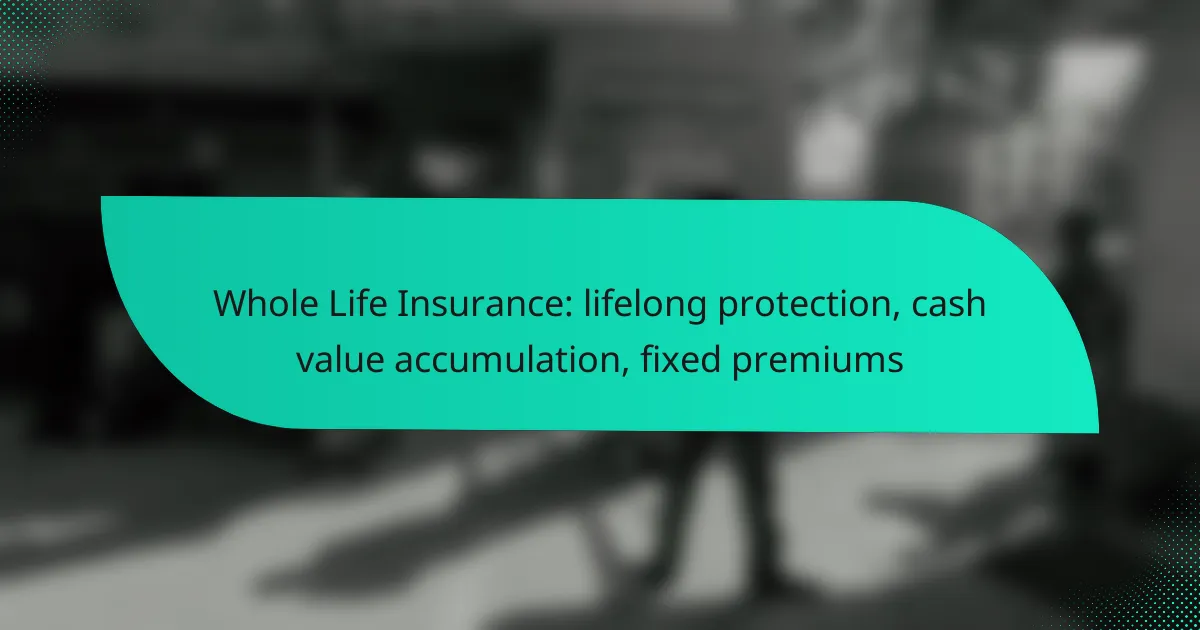Whole life insurance is a permanent insurance solution that offers lifelong protection and includes a cash value component that accumulates over time. With fixed premiums and a guaranteed death benefit, it provides financial stability and peace of mind for policyholders and their beneficiaries. This type of insurance not only secures your loved ones’ future but also serves as a valuable savings tool, allowing for potential borrowing against the cash value as it grows.

What is Whole Life Insurance?
Whole life insurance is a type of permanent life insurance that provides lifelong coverage and includes a cash value component. This policy guarantees fixed premiums and a death benefit, making it a stable choice for long-term financial planning.
Definition of Whole Life Insurance
Whole life insurance is designed to last for the insured’s entire life, as long as premiums are paid. Unlike term life insurance, which only covers a specific period, whole life policies accumulate cash value over time, which can be borrowed against or withdrawn. This makes it a dual-purpose financial product, serving both as insurance and a savings vehicle.
Typically, whole life insurance policies are structured to remain in force until the policyholder’s death, providing a guaranteed payout to beneficiaries. The cash value grows at a predetermined rate, offering a stable investment option within the policy.
Key Features of Whole Life Insurance
Whole life insurance has several key features that distinguish it from other types of life insurance. First, it offers fixed premiums, meaning the amount you pay will not increase over time. This predictability helps with long-term budgeting and financial planning.
Another important feature is the cash value accumulation, which grows tax-deferred. Policyholders can access this cash value through loans or withdrawals, providing liquidity if needed. However, it’s essential to understand that any unpaid loans will reduce the death benefit.
- Lifelong Coverage: Coverage lasts for the insured’s entire life.
- Fixed Premiums: Premiums remain constant throughout the policy’s life.
- Cash Value: Accumulates over time and can be accessed by the policyholder.
When considering whole life insurance, evaluate your financial goals and needs. This type of policy can be more expensive than term insurance, so weigh the benefits of lifelong coverage and cash value against your budget and financial strategy.

How does Whole Life Insurance provide lifelong protection?
Whole life insurance offers lifelong protection by ensuring that the policyholder’s beneficiaries receive a guaranteed death benefit upon the policyholder’s passing. This type of insurance remains in force for the entire life of the insured, as long as premiums are paid, providing peace of mind and financial security for loved ones.
Guaranteed Death Benefit
The guaranteed death benefit is a key feature of whole life insurance, ensuring that a specified amount is paid to beneficiaries regardless of when the policyholder dies. This benefit can provide financial support for dependents, cover outstanding debts, or fund future expenses like education or estate taxes.
Typically, the death benefit remains level throughout the life of the policy, meaning it does not decrease over time. It’s important to choose a death benefit amount that aligns with your financial goals and the needs of your beneficiaries.
Policy Longevity
Whole life insurance policies are designed to last a lifetime, as long as premiums are maintained. This longevity is a significant advantage compared to term life insurance, which only provides coverage for a specified period. With whole life insurance, policyholders can feel secure knowing their coverage will not expire.
To ensure the policy remains active, it is crucial to make timely premium payments. Some policies may also offer a grace period for late payments, but failing to pay could result in a lapse in coverage. Regularly reviewing your policy can help you stay informed about your coverage and any potential changes in premiums or benefits.

What are the cash value accumulation benefits?
Cash value accumulation in whole life insurance provides policyholders with a savings component that grows over time, offering both financial security and potential borrowing options. This feature allows individuals to build wealth while ensuring lifelong protection through their insurance policy.
Cash Value Growth Over Time
The cash value of a whole life insurance policy typically grows at a guaranteed rate, which can vary by insurer but often falls within a range of 2% to 5% annually. This growth is compounded, meaning that over time, the cash value can significantly increase, providing a financial resource for the policyholder.
For example, if you have a policy with a cash value of $10,000 growing at an annual rate of 4%, after 10 years, the cash value could reach approximately $14,800. This accumulation can be beneficial for future financial needs, such as funding education or supplementing retirement income.
Tax Advantages of Cash Value
One of the key benefits of cash value accumulation is its tax-deferred growth. This means that you won’t owe taxes on the gains as they accumulate, allowing your savings to grow more efficiently over time. Additionally, when you withdraw funds from the cash value, you can often do so without incurring immediate tax liabilities, provided you stay within certain limits.
However, if you withdraw more than what you have paid in premiums, the excess may be subject to taxation. It’s essential to consult with a tax professional to understand the implications of accessing your cash value and to ensure you maximize the benefits while minimizing tax exposure.

How are premiums structured in Whole Life Insurance?
Whole life insurance premiums are typically structured as fixed payments made regularly throughout the policyholder’s life. These payments ensure lifelong coverage and contribute to the cash value accumulation of the policy.
Fixed Premium Payments
Fixed premium payments in whole life insurance remain constant over the life of the policy. This means that the amount you pay does not increase as you age or if your health changes, providing financial predictability.
For example, if your fixed premium is set at $500 annually, you will continue to pay this amount each year, regardless of any changes in your circumstances. This stability can be beneficial for budgeting and long-term financial planning.
Comparison with Term Life Insurance Premiums
Unlike whole life insurance, term life insurance premiums can vary significantly based on the length of coverage and the policyholder’s age and health at the time of renewal. Term premiums are typically lower initially but can increase substantially when the term expires.
For instance, a 20-year term policy may start with a premium of $300 per year, but upon renewal, the premium could rise to $600 or more, depending on the insured’s age. In contrast, whole life insurance premiums remain stable, making them easier to manage over time.

What are the advantages of Whole Life Insurance?
Whole life insurance offers lifelong protection, cash value accumulation, and fixed premiums, making it a reliable financial product. Its benefits include guaranteed death benefits for beneficiaries and a savings component that grows over time.
Financial Security for Beneficiaries
Whole life insurance provides a guaranteed death benefit that ensures financial security for your loved ones after your passing. This benefit can cover expenses such as funeral costs, outstanding debts, and living expenses, giving your beneficiaries peace of mind during a difficult time.
When selecting a policy, consider the coverage amount needed to adequately support your beneficiaries. A common recommendation is to have a death benefit that is at least 10-15 times your annual income to ensure sufficient financial support.
Wealth Building Opportunity
The cash value component of whole life insurance accumulates over time, allowing policyholders to build wealth alongside their insurance coverage. This cash value grows at a guaranteed rate and can be accessed through loans or withdrawals, providing liquidity when needed.
Investing in whole life insurance can be a strategic part of a long-term financial plan. The cash value can serve as an emergency fund or be used for significant expenses, such as education or retirement. However, keep in mind that accessing cash value may reduce the death benefit and could incur fees or interest.

What should you consider before purchasing Whole Life Insurance?
Before purchasing whole life insurance, evaluate your long-term financial goals, the costs associated with the policy, and how it fits into your overall financial plan. Understanding these factors will help you make an informed decision about whether this type of insurance is right for you.
Personal Financial Goals
Consider how whole life insurance aligns with your personal financial objectives. This policy provides lifelong coverage and builds cash value, which can be beneficial for long-term savings or as a financial resource in emergencies.
Assess whether you need a policy primarily for protection, investment, or a combination of both. If your focus is on wealth accumulation, ensure that the cash value growth meets your expectations compared to other investment options.
Policy Costs and Fees
Whole life insurance typically has higher premiums than term life insurance due to its lifelong coverage and cash value component. Premiums can range from a few hundred to several thousand dollars annually, depending on factors like age, health, and coverage amount.
Be aware of additional costs such as administrative fees and potential surrender charges if you decide to withdraw cash value early. Always review the policy illustrations and ask for a breakdown of all costs involved to avoid surprises later.

How does Whole Life Insurance compare to other insurance types?
Whole life insurance provides lifelong coverage with a cash value component, setting it apart from other types of insurance. Unlike term life insurance, which offers coverage for a specific period, or universal life insurance, which allows for flexible premiums and death benefits, whole life insurance guarantees fixed premiums and a stable cash value accumulation.
Whole Life vs. Term Life Insurance
Whole life insurance differs significantly from term life insurance in that it offers lifelong protection and builds cash value over time. Term life insurance, on the other hand, provides coverage for a predetermined period, typically ranging from 10 to 30 years, and does not accumulate any cash value.
When considering these options, think about your long-term financial goals. Whole life insurance can be more expensive, with premiums often several times higher than term policies, but it offers the advantage of guaranteed payouts and cash value that can be borrowed against or withdrawn.
Whole Life vs. Universal Life Insurance
Whole life insurance and universal life insurance both provide lifelong coverage, but they differ in flexibility and cash value growth. Universal life insurance allows policyholders to adjust their premiums and death benefits, which can lead to variable cash value growth based on interest rates.
Whole life insurance, in contrast, has fixed premiums and a predictable cash value growth schedule. This predictability can be beneficial for those who prefer stability in their financial planning. However, universal life insurance may appeal to those who want more control over their policy and potential for higher returns, albeit with increased risk.

What are the common misconceptions about Whole Life Insurance?
Many people misunderstand Whole Life Insurance, believing it to be a poor investment or too expensive. In reality, it offers lifelong protection, cash value accumulation, and fixed premiums, making it a valuable financial tool for many.
Whole Life Insurance is too expensive
A common misconception is that Whole Life Insurance is prohibitively expensive. While premiums can be higher than term life insurance, they remain fixed throughout the policyholder’s life. This stability can be beneficial, especially as premiums for term policies increase with age.
Additionally, the cash value component grows over time, providing a potential return on investment. When considering the long-term benefits, Whole Life Insurance can be a cost-effective solution for those seeking lifelong coverage.
Whole Life Insurance doesn’t provide good returns
Some believe that Whole Life Insurance offers poor returns compared to other investment options. However, the cash value grows at a guaranteed rate, often around 2-4% annually, depending on the policy. This growth is tax-deferred, which can enhance overall returns over time.
While it may not match the high returns of stocks or mutual funds, Whole Life Insurance provides a stable, low-risk option for those looking to diversify their financial portfolio.
Whole Life Insurance is only for the wealthy
Another misconception is that Whole Life Insurance is only suitable for affluent individuals. In reality, policies can be tailored to fit various budgets and financial goals. Many insurers offer flexible premium payment options, allowing policyholders to choose a plan that aligns with their financial situation.
Moreover, Whole Life Insurance can be a strategic choice for middle-income families, providing both protection and a savings component that can be accessed later in life.
